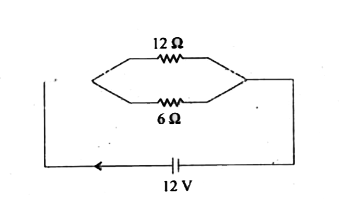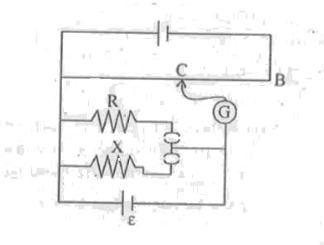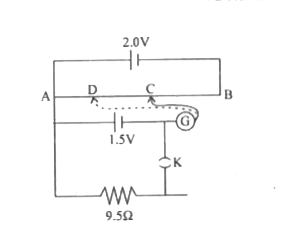Complete Solutions to NUMERICAL PROBLEMS AND ANSWERS of chapter CURRENT ELECTRICITY of Class 12 book with complete answers and questions
| Class 12 | PHYSICS |
| Chapter | CURRENT ELECTRICITY |
| SUBHASH PUBLICATION | NUMERICAL PROBLEMS AND ANSWERS |
| Number Of Questions | 29 |
| Academic Year | 2023-24 |
In the given circuit, calculate the effective resistance between A and B.
 03:33View Solution
03:33View SolutionIn the given circuit, calculate the current through the circuit when connected with `12V` supply.
 05:01View Solution
05:01View SolutionIn the given circuit, calculate the current through `3Omega` resistor, when circuit is connected to `12V` battery.
 04:13View Solution
04:13View SolutionA battery of internal resistance `3Omega` is connected to `20Omega` resistor and the potential difference across the resistor is 10V. If another resistor `30Omega` is connected in series with the first resistor and battery is again connectecl to the combination, then calculate the e.m.f and terminal potential difference across the combination..
04:43View SolutionA network of resistors is connected to a 12V battery as shown in the figure. Calculate the equivalent resistance of the network.
 02:03View Solution
02:03View SolutionA network of resistors is connected to a 12V battery as shown in the figure. Obtain current in `12Omega` and `6Omega` resistors.

03:04View SolutionTwo cells of emf 2V and 4V and internal resistance `1Omega` and `2Omega` respectively are connected in parallel so as to send the current in the same direction through an external resistance of `10Omega`. Find the potential difference across `10Omega` resistor.
05:11View SolutionWhich two resistors are connected in series with a cell of emf 2V and negligible internal resistance, a current of (2/5)A flows in the circuit. When the resistances are in parallel, the main current is (5/3)A. Calculate the resistances.
06:07View SolutionTwo resistors of resistances `2Omega` and `4Omega` are connected in parallel. Two more resistors `3Omega` and `6Omega` are also connected in parallel. These two combinations are in series with a battery of emf 5 V and internal resistance `0.7Omega`. Calculate current through the `6Omega` resistor.
06:59View SolutionThree equal resistors connected in series across a source of emf of negligible internal resistance together dissipate 10 W of power. What would be the power dissipated if the resistors are connected in parallel across the same source of e.m.f.
04:09View SolutionA copper wire has `3xx 10^(22)` free electrons in `0.021 m` length. The drift velocity of electrons is found to be `2xx10^(-5)ms^(-1)`.
How large a current will flow through the wire?02:42View SolutionA copper wire has `3xx 10^(22)` free electrons in 0.021 m length. The drift velocity of electrons is found to be `2xx10^(-5)ms^(-1)`.
How many electrons would pass through a given cross-section of the wire in one second?03:56View SolutionA cube of side `0.05 m` of a material of conductor is drawn into a wire of thickness `0.20 mm`. If the specific resistance of the wire is `10^(-6)Omegam` then calculate the resistance of the wire.
04:15View SolutionIf the number density of electrons in a conductor is `3 xx10^(28)` and thickness of the conductor is 5 mm, then calculate the current in that conductor for a drift velocity of `2 xx 10^(-4) ms^(-1)`. If the voltage applied is `500 V`, then calculate relaxation time. Given specific charge of electron = `1.76xx 10^(11)` C `kg^(-1)` , length of the conductor = 10 m
07:22View SolutionTwo resistors `10Omega` and `25Omega` are connected in series and the combination is connected across a 25 V source of negligible internal resistance. A voltmeter of resistance `25Omega` is connected across the `10Omega` resistor. Find the reading in the voltmeter. If another voltmeter of a very large resistance replaces the voltmeter, then find the reading of voltmeter.
07:27View SolutionFour resistors of resistances `2Omega, 1Omega, 3Omega, 4Omega` are arranged in a cyclic order to form a Wheatstone's network ABCD. The junctions B and D are connected to a galvanometer of resistance `2Omega`. A current of 0.1 A enters the junction 'A'. Calculate the current in the galvanometer.
09:48View SolutionABCD forms the four arms of a Wheatstone's network. The arms AB, BC, CD, DA are of `10Omega, 15Omega, 25Omega` and `20Omega` respectively. The junctions B and D are connected to the ends of galvanometer of resistance `25Omega`. If the source voltage is 5V, r = 0, then calculate the current in the galvanometer. Assume the branch currents across AB, BC, CD, DA and BD as `i_(1),i_(3),-i_(4),-i_(2),` and `i_(g)` respectively.
12:39View SolutionA battery of emf `10V` and internal resistance `3Omega` is connected to a resistor. If the current in the circuit is `0.5 A`, what is the resistance of the resistor? What is the terminal voltage of the battery when the circuit is closed?
03:59View SolutionThree resistors `2Omega, 4Omega` and `5Omega` are connected in parallel. What is the total resistance of the combination?
01:50View SolutionThree resistors `2Omega, 4Omega` and `5Omega` are connected in parallel.If the combination is connected to a battery of emf `20 V` and negligible internal resistance, determine the current through each resistor and the total current drawn from the battery.
04:31View SolutionA negligbly small current is passed through a wire of length 15m, uniform cross - section `6.0xx10^(-7)m^(2)` and its resistance is measured to be `5.0Omega`. What is the resistivity of the material at the temperature of the experiment?
03:08View SolutionA heating element using nichrome connected to a 230V supply draws an initial current of 3.2A which settles after a few seconds to a steady value of 2.8A. What is the steady temperature of the heating -element, if the room temperature is `27.0^(@)`C? Temperature cofficient of resistance of nichrome averaged over the temperature range involved is `1.70xx 10^(-4@)C^(-1).`
05:39View SolutionThe number density of free electrons in a copper conductor is estimated as `8.5xx10^(28)m^(-3)`. How long does an electron take to drift from one end of a wire 3.0m long to its other end? The area of cross-section of the wire is `2.0xx 10^(-6)m^(2)` and it is carrying a current of 3.0A.
03:55View SolutionThe earth's surface has-a negative surface charge density of `10^(-9) Cm^(-2)`. The potential difference of 400kV between the top of the atmosphere and the surface results in a current of only 1800A over the entire globe. If there were no mechanism of sustaining atmospheric electric field, how much time would be required to neutralize the earth's surface charge? Take radius of earth `= 6.37xx 10^(6)` m.
04:41View SolutionSix lead - acid type of secondary celJs each of emf 2.0V and internal resistance `0.015Omega` are joined in series to provide supply to a resistance of `8.5Omega`. What is the current drawn from the supply and its terminal voltage?
03:56View SolutionA secondary cell after long use has an emf of 1.9V and large internal resistance of 380 `Omega`.
What maximum current can be drawn from the cell? Could the cell drive the starting motor of a car?01:58View SolutionThe figure shows a potentiometer circuit for comparison of two resistances. The balance point with a standard resistor `R = 10.0Omega` is found to be 58.3cm, while that the unknown resistance 'X' is 68.5 cm. Determine the value of x. What might you do if you failed to find a balance point with the given cell of emf `epsilon`?
 05:19View Solution
05:19View SolutionA battery of internal resistance `3Omega` is connected to `20Omega` resistor and the potential difference across the resistor is 10V. If another resistor `30Omega` is connected in series with the first resistor and battery is again connectecl to the combination, then calculate the e.m.f and terminal potential difference across the combination..
04:43View SolutionThe figure shows a 2.0V potentiometer used for the determination of internal resistance of a 1.5V cell. The balance point of the cell in open circuit is 76.3 cm. When a resistor of `9.5Omega` is used in the external circuit of the cell, the balance point shifts to 64.8 cm length of the potentiometer wire. Determine the internal resistance of the cell.
 03:03View Solution
03:03View Solution
NUMERICAL PROBLEMS AND ANSWERS questions and complete solutions for chapter CURRENT ELECTRICITY of JEEVITH PUBLICATIONS PHYSICS (KANNADA ENGLISH) of Class 12
